Bionic men: Amputees say next-generation prosthetics respond like the real thing
(CBS News) BOSTON - Losing a leg once meant a lifetime of crutches and limping. But that is changing, thanks to some pioneers in Massachusetts, who have developed a prosthetic ankle that's closer than ever to the real thing.
Stefan Isenberg loves his job as a trash collector because it keeps him active, outside and on his feet. That's remarkable because years ago, Isenberg lost his right foot when a garbage truck rolled over it. Last fall, he replaced his missing foot with the future -- a kind of robot, a "bionic ankle."
It's called the BiOM. To understand what makes it bionic CBS News visited company headquarters outside Boston -- and tested the ankle ourselves by putting weight on it.
"The more you pushed on it -- the more it pushed back," said Hugh Herr, the lead developer of the BiOM and a professor at MIT.
Unlike a normal foot prosthetic that's essentially a spring, the BiOM is a machine packed with processors, gyroscopes and motors. It senses how fast the amputee wants to walk or run and then the robot responds like the body -- with force.
"So, when my foot hits the ground, it moves as if it has a calf muscle, an Achilles and it's being controlled by the spinal cord," Herr explains.
Herr has worked to perfect the bionic ankle ever since he lost both legs in a mountain climbing accident 20 years ago.
He helped build a company called iWalk that employs 60 people and is still ramping up. Some of his early funding came from U.S. military, which invested heavily in robotics -- and the BiOM ankle has gone to dozens of veterans who lost their feet in the wars.
He says the BiOM could transform the way the country treats war amputees.
"We have an opportunity to get all these many soldiers that that are returning with missing arms and legs and returning them to a very normal, high quality of life," he said.
For the users of bionic limbs, the biggest change isn't technological, it's profoundly human. Many amputees see the limbs as so functional, they stop seeing themselves as impaired.
"It's pretty amazing how it works, especially once you get used to it," Isenberg said. "I always forget that it's there."
He used to keep a mental list of where he could not go and what he could not do. Months ago bionic man threw the can't-do list away.

